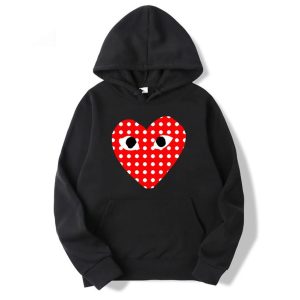Comme des Garçons, founded by the visionary Rei Kawakubo in Tokyo, is more than a fashion label—it is a cultural phenomenon that has revolutionized the global style narrative. When this avant-garde powerhouse entered the European scene, particularly in Germany, it redefined what it meant to be modern, artistic, and intellectually rebellious in fashion. Germany, long known for its precision, architecture, and minimalism, found an unexpected but profound partner in Comme des Garçons deconstructed chaos. Together, they created a new visual language that reshaped the nation’s contemporary fashion identity.
The Meeting of Two Aesthetic Worlds: Japan’s Avant-Garde and Germany’s Modern Minimalism
The intersection of Japanese avant-garde philosophy and German modern design is not merely stylistic—it is philosophical. Comme des Garçons’ approach to fashion has always challenged the very essence of beauty, questioning perfection and symmetry. In contrast, Germany’s aesthetic heritage, influenced by the Bauhaus movement, values clarity, structure, and form following function.
When Rei Kawakubo’s abstract silhouettes and experimental tailoring met Germany’s disciplined eye, a new hybrid aesthetic was born—one that balanced emotional chaos with technical precision. German fashion enthusiasts, artists, and designers embraced this contrast, seeing in Comme des Garçons a form of intellectual liberation that resonated deeply with Berlin’s growing avant-garde culture.
Rei Kawakubo’s Conceptual Influence on German Designers
Rei Kawakubo’s work transcends fashion—it is conceptual art expressed through fabric and form. Her radical collections of the 1980s and 1990s, often described as anti-fashion, introduced Germany to an entirely new creative vocabulary. The notion of “beautiful imperfection,” or the Japanese concept of wabi-sabi, began to seep into the ethos of German design education and creative industries.
Emerging German designers started to move away from commercial uniformity and instead explored distortion, layering, and asymmetry. Labels in Berlin, Hamburg, and Munich began experimenting with unconventional materials, distressed textiles, and sculptural silhouettes that mirrored Comme des Garçons’ artistic rebellion. The influence extended beyond clothing—graphic designers, photographers, and architects found inspiration in Kawakubo’s defiance of traditional form and proportion.
Berlin: The Epicenter of Comme des Garçons’ German Renaissance
Berlin, with its deep artistic roots and a history of reconstruction, became the perfect stage for Comme des Garçons’ arrival in Germany. The city’s culture thrives on contrast—past and future, order and chaos, destruction and rebirth—mirroring Kawakubo’s own creative process.
Comme des Garçons’ Berlin store, designed with minimalistic brutality and an almost gallery-like atmosphere, became a hub for artistic exchange. The brand’s presence blurred the lines between fashion, art, and performance, attracting a generation of creatives who saw clothing not merely as apparel but as an expression of identity and intellect.
Collaborations with local German artists and concept stores elevated Comme des Garçons to iconic cult status. The brand’s runway pieces became conversation starters, symbols of individuality and nonconformity. Within Berlin’s underground culture—clubs, galleries, and fashion collectives—Comme des Garçons became synonymous with intellectual rebellion and aesthetic depth.
Cultural Symbiosis: Redefining Fashion Through Emotion and Intellect
The relationship between Comme des Garçons and Germany is one of mutual transformation. While the brand influenced the German fashion landscape, Germany also gave Comme des Garçons a new audience—one that appreciated the interplay of structure and disruption.
German fashion culture, traditionally leaning toward functionality, started to adopt a more emotional and narrative-driven approach. Comme des Garçons’ collections, with their haunting beauty and poetic imperfection, encouraged German consumers to view clothing as a philosophical statement rather than a commodity.
This shift also inspired major fashion schools in Germany, such as those in Berlin and Düsseldorf, to adopt conceptual and experimental design methodologies. Students studied Comme des Garçons not just as a brand but as a case study in avant-garde innovation—a living example of how fashion could transcend market trends to become an art form.
The Business of Rebellion: Comme des Garçons in Germany’s Luxury Market
While avant-garde fashion often exists on the fringes, Comme des Garçons successfully established itself as a luxury brand with a radical soul. In Germany, its unconventional approach attracted both intellectual elites and the youth subcultures of Berlin and Hamburg.
The brand’s diffusion lines—Comme des Garçons Play, Black Comme des Garçons, and Comme des Garçons Homme Plus—bridged the gap between conceptual artistry and wearable design, allowing German consumers to access avant-garde aesthetics in daily life. The heart logo, designed by Filip Pagowski, became a symbol of understated rebellion and minimalist irony—values that resonated deeply with German sensibilities.
Retail collaborations, pop-up installations, and exhibitions across Germany further expanded Comme des Garçons’ cultural footprint. The brand’s ability to combine artistic experimentation with commercial strategy solidified its place as a cornerstone of Germany’s evolving fashion identity.
Reimagining German Identity Through Deconstruction
Comme des Garçons’ philosophy of deconstruction echoes Germany’s own historical and cultural evolution. Post-war Germany rebuilt itself through reflection, reconstruction, and reinvention—values mirrored in Kawakubo’s practice of destroying form to create new meaning.
In both art and fashion, Germany’s new generation adopted a mindset of critical creation—questioning norms, breaking boundaries, and embracing imperfection. Comme des Garçons became both a metaphor and a model for this transformation. The brand’s exploration of gender fluidity, emotional complexity, and anti-commercialism aligned with the progressive, inclusive spirit of German youth culture.
The Future of Avant-Garde Fashion in Germany
As Germany continues to evolve as a center for creativity and sustainable innovation, Comme des Garçons remains a guiding force in shaping future design philosophies. Its influence can be seen in the rise of independent German labels that prioritize authenticity, artistic expression, and cultural dialogue over mass production.
Fashion weeks in Berlin increasingly showcase collections that defy trends, focusing instead on storytelling and individuality—an approach pioneered by Comme des Garçons decades earlier. Kawakubo’s legacy continues to inspire German designers to question not only what fashion is, but what it could become in a world driven by technology, diversity, and sustainability.
Conclusion: A Continuing Dialogue Between East and West
The relationship between Comme des Garçons and Germany is far more than aesthetic admiration—it is an ongoing dialogue between CDG Hoodie East and West, tradition and innovation, order and chaos. In merging Japan’s avant-garde philosophies with Germany’s disciplined creativity, a new cultural identity emerged—one that values both introspection and experimentation.
Through Rei Kawakubo’s vision, Germany discovered that true style is not about conformity, but about creative defiance. Comme des Garçons did not just reshape Germany’s contemporary fashion identity—it helped redefine the very nature of fashion itself.





